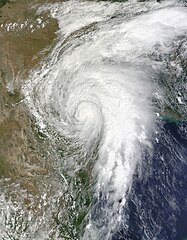Interesting read:
http://www.window.state.tx.us/specialrp ... yTimes.php Scenario 2: Severe Drought
In a severe drought such as the drought of record, Texas might average between 22.5 and four inches of rain annually, moving from east to west, for five to 10 years.
Consequences:
Surface water supplies are strained, requiring more extensive use of both fresh and brackish groundwater.
Texas’ municipalities are forced to absorb millions of dollars in costs to fix water mains cracked and buckled by dried-out soils.
Municipal water rates may rise dramatically.
Texas agriculture takes billions of dollars in losses. Many farmers stop planting, and some leave the business entirely. Cattle herds are greatly reduced as forage becomes prohibitively expensive.
As a result, food costs may rise substantially.
Many businesses based on recreation on Texas lakes and streams dry up and disappear.
Destructive wildfires may sweep through the tinder-dry state each summer, destroying millions of dollars’ worth of homes, businesses and timber.
Irrigation of trees, shrubs, flowering plants and lawns is restricted; many plants used in landscaping die.
Lack of rainfall leads to increased salinity in Texas’ bays and estuaries, damaging oyster, shrimp and crab yields.
Low-flush and dual-flush toilets and other low-flow water appliances are required or strongly recommended and may receive significant tax and installation rebates.
Texans face “convenience costs” as well — scarce and expensive water makes Texans think twice about using appliances they once took for granted, such as dishwashers and clothes washing machines.
Scenario 3: MegaDrought
Texas’ water planning process uses the 1950s “drought of record” as a worst-case scenario. Unfortunately, scientific evidence from tree-ring studies indicates that the 1950s drought may be far from a true worst-case scenario.
Say that Texas receives half of its “normal” average annual rainfall, 13 inches or so, for two decades. Our semi-tropical regions would become arid, while our semi-arid regions would become desert. This situation would create tremendous social changes.
Consequences:
Texas agriculture would change dramatically, and might end in some areas. Drip irrigation and other techniques pioneered in desert areas would become essential.
Remaining agriculture might become dependent on “water markets,” in which the rights to draw groundwater are bought and sold.
Food prices, particularly beef prices, would increase significantly.
Turf grass lawns and all outside watering might be banned.
Low-flow water appliances would become mandatory.
Wastewater would become quite valuable, and would be reclaimed for reuse in irrigation and perhaps treated to make it suitable for human consumption.
Desalination of brackish (salty) groundwater and seawater would become common, at first for industrial and agricultural uses and then for drinking water.
Utility rates could be expected to skyrocket due to the increased expense of water obtained through desalination or reuse, and the higher costs faced by energy plants that rely on water for cooling.
The above post and any post by dhweather is NOT an official forecast and should not be used as such. It is just the opinion of the poster and may or may not be backed by sound meteorological data. It is NOT endorsed by any professional institution including storm2k.org. For official information, please refer to NWS products.
 The posts in this forum are NOT official forecast and should not be used as such. They are just the opinion of the poster and may or may not be backed by sound meteorological data. They are NOT endorsed by any professional institution or
The posts in this forum are NOT official forecast and should not be used as such. They are just the opinion of the poster and may or may not be backed by sound meteorological data. They are NOT endorsed by any professional institution or 

















